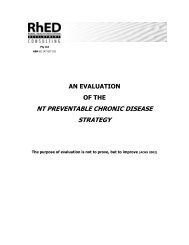DHF Annual Report 2009 - NT Health Digital Library - Northern ...
DHF Annual Report 2009 - NT Health Digital Library - Northern ...
DHF Annual Report 2009 - NT Health Digital Library - Northern ...
You also want an ePaper? Increase the reach of your titles
YUMPU automatically turns print PDFs into web optimized ePapers that Google loves.
18The role of legislation in improvinghealth outcomesContemporary research drives policy, which in turnunderpins legislation and regulatory regimes thatprotect people from harm.Tobacco use continues to be the number one causeof preventable death and illness in the <strong>Northern</strong>Territory and is directly implicated in over 15 000deaths in Australia each year and leaves many moredisabled or chronically ill. Nearly 20% of adult deathsand 3% of hospital admissions in the Territory areattributable to smoking.During <strong>2009</strong>-10 the amendments to the TobaccoControl Regulations removed the exemption forlicensed premises to comply with indoor smokingbans. This change was successfully implemented on 2January 2010, resulting in a complete ban on smokingin all enclosed public areas in the Territory. This inturn, has seen an increase in calls to the Quitline ofcomparison to the same period in <strong>2009</strong>.In June 2010, further reforms to the <strong>Northern</strong> TerritoryTobacco Control Act saw the introduction of: a ban on smoking in all public outdoor eatingand drinking areas (with exempt areas for the prohibition on the display of tobacco products power for owners and occupiers of outdoorpublic areas to declare the area smoke free with licensing of tobacco retailers which will requirean annual licence fee and renewal process, aswell as new licence conditions that will ban fruitdata to be submitted.These amendments complete Government’scommitment to tobacco control reform to ensurethat the Territory now has a regulatory framework ontobacco comparable with other legislation in Australia.to protecting staff and the public from environmentaltobacco smoke, reducing exposure to smoking andtobacco products and improving the monitoring oftobacco sale and supply.Amendments to the Volatile Substance Abuse Actalso came into effect during <strong>2009</strong>-10. These changesallow for more expedient assessment processes andDepartment <strong>Health</strong> and Familiesexpansion of mandatory treatment options that is notonly residential but also non residential and otherappropriate interventions, thereby increasing thescope of treatment options.Although not directly responsible for alcohol legislation,the Department has professionals with specialistknowledge and interest in alcohol prevention, educationand health promotion who contribute to policy andprogram planning in partnership with the Departmentof Justice and <strong>Northern</strong> Territory Police. This year, theDepartment was involved in an analysis of the Costsand Harms of Alcohol within the <strong>Northern</strong> Territory.The report shows that Territorians are drinkingat levels far in excess of the rest of the country.On average, Australians drink approximately 10 litresof pure alcohol per person per year and Aboriginal andnon-Aboriginal Territorians consume approximately15 litres per year, which is 50 per cent higher.The total social cost of alcohol in the <strong>Northern</strong>Territory is estimated at $642 million per year. At acost of $4197 per adult, this is substantially higherthan the national level of $943.There are a number of potential legislative andenforcement measures currently being considered toreduce consumption and subsequent harms causedby alcohol, however the drinking culture of theTerritory must also change. This high consumptioncannot be simply attributed to a small number of‘problem drinkers’ in certain sectors of the community,heavy and regular alcohol consumption is considereda social norm and this needs to be further opened upto public debate.We cannot waitThe rapid rise in the prevalence of chronic conditionsis seen nationally and throughout the developedworld and is predicted to increase. In the Territory wehave the added burden with even higher rates in theAboriginal population. The social and health servicecosts of our burden of disease and injury placeconsiderable pressures on our hospitals and primaryhealth care services and society at large.This situation makes it imperative that the Territoryplaces a priority on prevention, to address thedeterminants of health and social risk factors, torecognise the importance of early years throughinvestment in early childhood health, family supportand education services as well as to provide bestpractice management of chronic conditions.
















